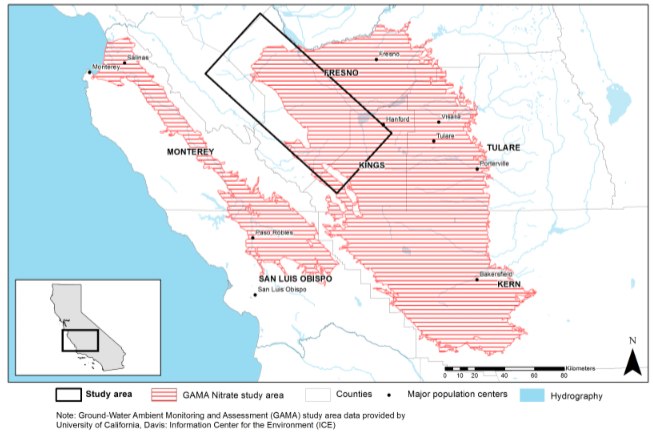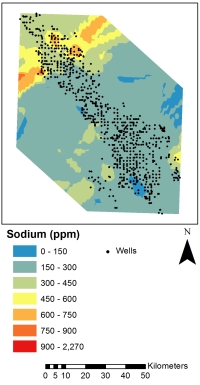Advanced Tools for Consolidation of California’s Groundwater Data
Groundwater is a critical resource to the state of California’s health and economy. Nearly 37 million people and large industrial manufacturing and high technology industries and agriculture rely on ground and surface water for daily consumption. Groundwater has only recently been realized as integrally linked with surface water and placed under environmental regulations. Groundwater is a resource that is very difficult to monitor from the surface. There are limited data available to help inform a deep understanding of the needs required to protect the use of this resource. State-wide and historical groundwater quality and quantity data is needed to address the many questions facing those who rely on this resource and those charged to protect it. Much of the history of groundwater in the state is locked in locally operated and paper based archives dispersed throughout the state all with their own data standards. Standardized and digitally referenced groundwater data is required to enable the detailed analysis of local, regional, and state-wide groundwater needs and trends; to prioritize issues, areas and techniques to focus limited resources on; to enable the prediction of future scenarios of groundwater conditions; and to examine the linkages of groundwater to other environmental issues.
The objective of this project was to test protocols for acquiring, consolidating, digitizing, and developing products from analog groundwater data from a variety of sources. This pilot research integrates archival groundwater data from the 1950s in Fresno and Kings counties into a digital spatial database. Useful information on the condition of groundwater in the area and time period was successfully digitized, extracted, and analyzed from the original archival data. Statistical and spatial analyses of the digitized data provide a detailed picture of the groundwater in this area in the 1950s.
 Our study area in Kings and Fresno Counties
Our study area in Kings and Fresno Counties
Analog spatial and tabular data from a 1957 USGS Water Supply paper was digitized and integrated into a digital spatial database. The data contains detailed information on 797 wells including well construction and groundwater constituents such as pH and Sodium concentrations and groundwater depth. The following are examples of statistical summaries that can be extracted from the digitized data: The wells sampled had alkaline pH levels from 2.30 to 9.30 (mean 7.62); Chloride averaged 154 ppm with a maximum of 2,310 ppm; Percent sodium averaged 62 % with a maximum of 97 %. Well water height ranged from 53 to 562 ft (mean 289 ft). Spatial kriging was used to interpolate well constituents producing continuous surfaces of attribute information.
The digitized data can be used to create numerous spatial data products such as groundwater elevation contours and constituent interpolated surfaces that can be used to visualize or analyze attributes over space, and aid in determining change, trends, risks, and vulnerabilities to groundwater and its use.  Interpolation of sodium from 1957Historical digital groundwater information that is standardized and spatial can be coupled with other types of multi-temporal spatial data such as climate, land use, and pollution data. In aggregate these data can be used to analyze externalities on groundwater and their effects on groundwater quantity and quality. In addition the groundwater database can be used as a point of comparison in a time series paired with other groundwater data from different years to analyze spatial and statistical change and trends over time. Historical groundwater data can also be used in spatial and statistical modeling for planning and assessing future groundwater risks and vulnerabilities.
Interpolation of sodium from 1957Historical digital groundwater information that is standardized and spatial can be coupled with other types of multi-temporal spatial data such as climate, land use, and pollution data. In aggregate these data can be used to analyze externalities on groundwater and their effects on groundwater quantity and quality. In addition the groundwater database can be used as a point of comparison in a time series paired with other groundwater data from different years to analyze spatial and statistical change and trends over time. Historical groundwater data can also be used in spatial and statistical modeling for planning and assessing future groundwater risks and vulnerabilities.
This research illustrates the process and possibilities of taking historic, static, paper maps and tables of groundwater information and transforming them into a dynamic, spatial digital database. The digitized groundwater data in this study not only provides a snapshot of groundwater conditions for a particular place and time but also provides a point of comparison and a base from which further study can begin from. The format of digital spatial data permits the use of advanced digital visualization platforms such as those based on webGIS technologies that have web based data visualization, analysis, and export capabilities to present and analyze data. Digital spatial data pared with the growing reach and ubiquity of internet based technologies has the potential to expand the use and value of these data, making the data more easily accessible to the public, scientific researchers, and policy makers.
Funded by CITRIS. The Berkeley Water Center (BWC), Berkeley’s Geospatial Innovation Facility (GIF), and the U.C. Davis Information Center for the Environment (ICE) collaborated to make California’s groundwater data more easily accessible to the research community, as well as the general public. Sam Blanchard worked on this project. Click here to view a poster on this project that gives background information on the issue and details on the research goals and methods. CITRIS webpage.
